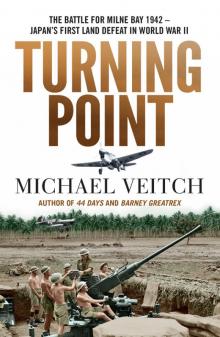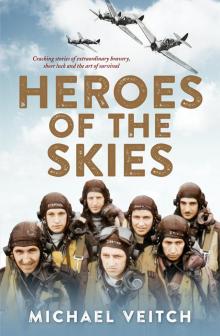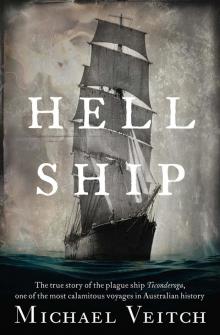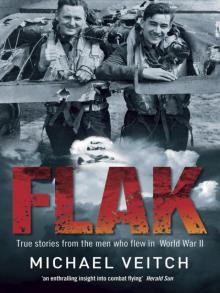- Home
- Michael Veitch
Flak Page 8
Flak Read online
Page 8
Being young and possessing outstanding natural aptitude, he had qualified for nearly every volunteer’s dream, single-engined pilot training. But Tom’s ambitions were not typical.
‘I didn’t want to stooge around at 30,000 feet never meeting the enemy’, he said, and so when asked to state his flying preference, Tom was one of a mere two per cent who nominated ‘army cooperation’. His flying career would be much closer to the ground, supporting the needs of the advancing army.
After qualifying, Tom had the melancholy experience of departing overseas from the heart of his very own neighbourhood at Station Pier. I had an image of him being seen off by his family, watching his home recede into the distance, wondering if he would ever see it again. But it wasn’t nearly so romantic. He left at night and in secret, having farewelled his family long before. Perhaps that’s even sadder.
Even before he left the country it was dangerous. Memorials all over Australia at aerodromes past and present attest to the numbers killed in training accidents. It’s not hard to see why.
‘We used to practise dogfights at low-level over the lake at Mildura. One bloke would try to strafe the surface shadow of the plane in front of him! We lost so many. It was wicked.’
Take-off in the Typhoon was a matter of timing and correction, using the rudder to compensate for the big torque swing as the tail wheel left the ground, generated by the Sabre’s enormous 2200 horsepower. Even starting up was an issue, with a groundcrew required to stand by, fire extinguisher at the ready, in case the pilot over-primed the engine and started a fire in the radiator. Tom’s friend and fellow pilot Bill Speedie wasn’t deft enough on his first flight and narrowly missed collecting a hut situated a considerable distance off the runway. I flipped through Tom’s book as he talked and came across a photo of Bill Speedie in Normandy, an impish looking lad with a mop of wavy hair.
Sometimes the air force was a rigid, highly organised machine, at other times it was the opposite. In May 1944, Tom arrived at Number 83 Group Support unit at Redhill in Surrey to complete training on the Typhoon before being assigned to an operational squadron. It was not what he expected. There was no training schedule and hardly anyone there to teach. Eventually, a bloke he assumed must be an instructor mumbled, ‘Um, what would you like to do?’ Tom had to think.
‘Well we could, maybe, practise?’
‘Yes. Alright then.’
And off they went, flying at 20 feet above the paddocks, blowing the hats off the farmers working the tractors and roaring away before their identifying numbers could be read.
Tom was assigned to number 175 Squadron, earmarked to join the impending invasion of Europe, supporting the army in ground-attack operations.
He exchanged his air force uniform for the khaki battle dress of the army, on account of its dangerous resemblance to the blue grey of the Germans, and was made to get used to living in tents, as they would soon have to do on the Continent. White lines were drawn on the runway to the reduced dimensions of their forward bases within which they were made to practise landings and take-offs. Big thick, black and white stripes were painted on the underside of the Typhoon’s wings for extra recognition, the so-called ‘invasion stripes’.
On the morning of 6 June 1944, D-Day, Tom was in the air at 7 am, heading towards France to attack a gun battery on the coast near Cabourg on his first operation. It was all he could do to concentrate on the job. Below him was stretched the awesome, never-to-be-repeated sight of 5,000 ships carpeting the ocean – the great Allied invasion armada. Sixty years later, his eyes still misted over at the image.
‘Staggering,’ is all he could say.
He’d been told to use his cannon on the way into the target, and to fire his rockets in a salvo. Out of a formation of twelve Typhoons, Tom was lucky last.
He lined up his aircraft at the biggest gun he could see and fired his rockets. In Typhoons, these are slung on rails, four on each wing, and operated by a switch on the throttle. In effect, they were the world’s first air-to-surface missiles. There was a bang behind his head as a 20-millimetre cannon shell hit his aircraft on the starboard side just behind him, then passed out through the other side before exploding, taking a large chunk of the fuselage with it. Immediately the port wing dipped and started to drag. Gingerly, Tom tested the control surfaces and found all to be functioning. By compensating with opposite rudder, he made it back to England.
On the ground, his fitter looked at the hole in astonishment.
‘What was it like?’ he enquired of his first trip.
‘Draughty,’ said Tom.
The next day he was on again, flying alongside a more experienced pilot, Kelly Kelsic, swooping along at low level to stop German armour reaching the invasion beaches. Flying the 7-ton Typhoons at this altitude was incredibly dangerous and the casualty rates were enormous. Tom spotted the barrel of a tank under the fringes of a tree at the edge of a forest.
‘I can see one,’ he called on the radio/telephone.
‘Skittle it,’ replied Kelsic.
But Tom hadn’t seen it quite early enough. He yanked the controls around too hard and started to lose control of the aircraft. It skewed sideways.
‘I was skidding,’ he told me. A strange notion for an aircraft, but I knew what he meant. He fired his rockets and missed. This gave the enemy the chance to retaliate and a machine gunner on the tank opened up.
Tom felt the thud of bullets hit his aircraft somewhere.
‘I’ve missed him!’ he called out.
The more experienced Kelsic did not, came in and set the tank on fire.
Back in England, the rigger looked over his aircraft in wonder.
‘You’ve been lucky,’ he said, and called Tom over to see the results of his day’s work. Four bullets had struck the aileron, each missing one of the vital hinges by millimetres. If even one had hit, the aileron would have jammed, making the aircraft impossible to control, careering into the ground or upwards into a stall. And at the low level Tom was flying at, bailing out was not an option. That night, he quietly contemplated his situation for the first time.
‘This game’s for keeps,’ he concluded. He would be needing a lot more of the luck that had saved him that day.
In late June, his squadron moved to France to its new permanent base, a rough airstrip bulldozed out of a Normandy wheat field and covered with steel matting known simply as B5. A line of tents, their new accommodation, awaited them.
Some mornings he would find himself waiting on a ‘cabrank’, one of four airborne Typhoons ready to be called in by the army to a pinprick on a map at a moment’s notice. ‘Red mortar smoke going down in one and a half minutes’, would come over the air from an observation officer on the ground far below. And in they’d go. Sometimes the target would be a tank or a truck, sometimes lines of retreating German soldiers. In August at Falaise in Normandy, the Germans were corralled into a tiny pocket, with only one road left open to escape towards the east. It was carnage. As Tom says in his book:
We rippled the rockets (fired them in pairs) then separately we did cannon attacks into the massed crowds of soldiers. We would commence firing, and then slowly pull the line of cannon fire through the crowd and then pull up and go around again and again until the ammunition ran out. After each run, which resulted in a large vacant path of chopped up soldiers, the space would be almost immediately filled with other escapees.
It was a long hot summer and clouds of dust blew up from the Typhoon’s backwash, attracting German artillery. The pilots sweated like pigs inside the Typhoons’ big perspex bubble canopy, encouraging them to dispense with the cumbersome Mae West life jacket. One afternoon in October, with Normandy long behind them, Tom watched as fellow pilot and Tom’s long-suffering French teacher, Ross Clarke from Canada, bailed out over the B5 landing strip after having been hit by flak. All was well and a thumbs up given and returned. Then he could see Clarke panic as he realised he was heading for the middle of the River Meuse. He started swinging vi
olently on his parachute to try and reach the bank, missed and went straight under. His body was later found downstream. Tom remembered Clarke’s exasperated attempts to instil into Tom’s Australian accent the subtleties of the French tongue.
After this fatality the order went out: everyone was to wear the Mae West at all times.
‘Did you attack many trains?’ I asked.
‘Trains were our bread and butter,’ he replied.
If they had steam up, he remembered, there’d be a tremendous explosion.
‘How did you actually aim the aircraft? Was there a way of sighting it?’
‘It was optical, a light that would appear as if 60 feet in front of the aircraft. We had to learn deflection shooting. Not easy.’
As the memories flood back like a tide, I could see that one particular incident still disturbed him greatly.
February 27 1945 was a miserable winter’s day for the pilots of 175 in their forward base in Volkel, Holland. The weather was so bad there was to be no flying that morning. To pass the time many of them were playing bridge around a small table. Tom, one of the most senior pilots, was now often leading the squadron. The week before, he’d swooped down out of the sun to see a German V2 rocket about to take off to drop somewhere on London. The squadron fired and a massive explosion was witnessed. Then a call came through for four aircraft to take off and look for targets in the Lake Steinhuder area near Hanover. A ripple of unease went through the group as they glanced up at the heavy sky. The overcast cloud was down to 6,000 feet (1,800 metres). The commanding officer, Rollo Campbell, decided that his three wingmen would be chosen by the draw of a low card, but excused Tom due to the already high number of ops he’d completed, 120. Tom refused, and drew a three, along with Pilot Officer Ainsley and another experienced pilot and great friend, Warrant Officer Asher, an immensely likeable bloke from the West Indies.
The four took off, climbing through thick cloud and setting course for the target area, equipped with rockets and a single long-range fuel tank. Over the target, not one break in the cloud cover presented itself. It seemed a pointless exercise, but the four planes dived into it, line abreast. Diving down through cloud, Tom had a terrible, creeping feeling. As his airspeed built up, he counted off the seconds into the dive. There was, he knew, always a lag in the altimeter, and these instruments, bumped and thumped around daily in combat, were not ones he felt safe about relying on anyway. In front of him was nothing but white. The seconds ticked by, his airspeed increasing to over 500 miles an hour.
‘You just couldn’t see anybody!’ Tom said, wringing his hands, his voice rising.
He wanted to open the radio and say to his commanding officer, ‘We’re too low, pull up!’ But you never said that. Not ever. Not when someone else was in charge. But this time he had to. Tom pushed the button to transmit. As he did so, he heard his CO’s voice.
‘We’re . . .’ It was all he needed. The instincts of 120 operations kick in and he pulled the stick back hard, blacking out. The speed washed off as they broke through the cloud. Asher was missing. They circled and waited, then headed back to base in silence.
Tom remembered seeing the cards on the table, Asher’s bridge tricks laid out from the game they’d played a couple of hours before.
Four weeks later the army advanced and found the remains of Asher and his Typhoon. For Tom, it was a terrible realisation. They had all been flying down into a valley, in cloud. Asher, on the far left, with 109 ops in his log book had hit one side and crashed. The others, similarly unaware, could not have been far away from catastrophe themselves.
Tom’s face is dark with the memory of that fatal crash sixty years earlier. I looked at his book. The photographs of himself as a young pilot show the same troubled expression. Pictured in his flying gear mounting the wing of his mighty Typhoon, or against a hut, parachute pack slung over his shoulder, smiling weakly, the worry is evident behind the eyes.
Tom completed 122 ops on Typhoons – an astonishing tour and one he was very lucky to survive – and earned his DFC ten times over.
‘I reckon I took other people’s luck,’ he said modestly. ‘I saw boys on their first trip, dead as a doornail.’
As I left, Tom was calm and friendly. I didn’t know who felt more drained after our conversation, me or him. I started to tell him what a privilege it has been to talk to him, but I sensed this would probably embarrass him. Instead I just said, ‘It’s been great to meet you.’ And it was.
8
Bruce Clifton
Pilot
You just couldn’t get your mind around the fact that
you were going to get killed.
Bruce Clifton gave me one of the most extraordinary stories I had ever heard, on an afternoon I shall never forget. Not that I had any inkling of this on the long drive to his home in central Victoria. Every interview was like a lucky dip. Some were disappointing, while others turned up unexpected gems that made my head spin for days. By the sixth or seventh, I also started to feel that I was hitting my straps, and a pattern was starting to emerge as to how I would go about winning these peoples’ confidence. First, I let them size me up. This usually took about twenty minutes while I made small talk over a mug of tea. Then I would casually drop something in to the conversation like, ‘Ah, I see you have both the DFM [Distinguished Flying Medal] and DFC [Distinguished Flying Cross]. How long were you in the ranks?’ Or, if my subject were a turret gunner, ‘Did you ever use the Rose Brothers turret, or simply the Frazer-Nash?’ These and other nerdy minutiae were designed to both impress and relax my subject. Sometimes it worked, sometimes it didn’t.
All I knew of Bruce was that he had been a Lancaster pilot at the very end of the war in Europe. He met me on the front lawn of his home, greeting me in front of a large, well-kept camellia. I immediately found him warm, intelligent and engaging, free of the residue of cynicism that people can sometimes pick up from a lifetime in the city.
He dashed about inside, making me tea, asking me about the drive up and introducing me to his wife, Marie. Sandwiches and biscuits of generous proportion emerged.
Bruce apologised for what he described as ‘mess’ on the kitchen table. It was in fact his mini museum, souvenirs from his few months flying heavy bombers. I noticed his badge of the ‘Caterpillar Club’, membership of which can only be awarded by bailing out of an aircraft with the aid of a parachute. As I cast my eye over the table, he handed me a leave pass from a Swedish internment camp and mumbled something about a funeral. I look at it, unsure of its relevance, feeling as if I’d lost track of a story I was supposed to have been following. I asked him to start at the beginning.
‘Yes, let’s not get ahead of ourselves,’ he agreed.
One day at school, Bruce heard the news that his country was at war. He remembered the various reactions of the boys around him. Some cheered; others, especially those whose fathers had served in the First World War, were quieter. It was a Monday. Quite a way to begin the week. By the time his schooling had finished, the Battle of Britain and the legend of the sangfroid Spitfire pilot with a pipe and a cravat was already the stuff of schoolboy adoration.
Having qualified for pilot training, Bruce found himself at Nerrandra near Mildura, in the cockpit of a Tiger Moth with the instructor from hell. A screamer by the name of Dalby, any mistake from his pupils was met with a barrage of abuse: ‘Fucking hell! Turn the bloody stick! Why am I wasting my friggin’ time with you?!’ Bruce’s parody of his old instructor is amusing and comes out of nowhere, as if still smarting for torments afflicted sixty years ago and still hoping for a little revenge. Perhaps this is the very determination that got him through.
His first solo was one of the great moments in his life, akin he told me (out of his wife’s earshot) to the birth of his children. He remembered it vividly. He had been practising landings all morning. On the runway in the dual control biplane Tiger Moth, his instructor (a different one of the non-screaming variety), who was seated in front of him, reached
down and pulled out the split pin that secured his control column, removed it and threw it out of the aircraft. Bruce started hyperventilating. The other man climbed out, leant towards him and said, ‘Right. All you have to do is exactly what we’ve been doing up till now.’ Then he stepped back and sat down on the grassy verge. ‘You’re on your own, lad,’ he called and Bruce was off. At 1,000 feet (300 metres), doing a circuit, he yelled a long, extended ‘Yee-hah!’
Soon after, Bruce was posted to another school to progress onto flying the all-Australian built Wirraway, only to spend the next two months doing dishes. The sad story of the monster that was the Commonwealth Aircraft Corporation CA-1 Wirraway could fill a book on its own, but one of its more peculiar vices was that when being adapted from another aircraft, the American Harvard trainer, the rudder axis was for some reason brought forward, making the pedals extremely hard to reach for any pilot under 6 feet tall. To compensate, the air force for a time resorted to installing wooden blocks on the rudder bars! Bruce was thankfully spared this ignominy but lost two months waiting for a place in another school. An entry in his log book summed it up: Insufficient leg length for Wirraway aircraft.
I could see that Bruce was enjoying himself immensely as we pored over the details of his log book and he explained the various codes of the training program. His memory was fabulous, recalling such details as the flavour of the ice-cream eaten onboard the American ship which took him to San Francisco, a trip he shared with several hundred American soldiers, who in the fighting in the Pacific had mentally and emotionally cracked and were being evacuated home. It was a sobering contrast to Bruce and his compliment of young air force graduates with their fresh faces and new dark-blue uniforms.
Upon arrival in England, he was sent to number 9 Squadron in Bardney, Lincolnshire, to re-start his training and to see just what went on at an operational heavy bomber base. Just eighteen, Bruce was younger than most pilots. As first, he would sit by the runway as the Lancasters were taking off at dusk, giving them a red or green light by hand-held lamp as they lined up to roar off into the night. Soon, he knew, the situation would be reversed and it would be him being signalled for take-off. Later the same evening, he would be on Flying Control, in the air as part of an airborne air traffic control system as the returning bombers came in, often with dead and wounded aboard. He would often hear the dramatic dialogue between radio operator and control tower. ‘Hello Mayflower, this is A-Able. Request emergency landing. Two engines shot out. Mid-upper gunner dead,’ and so on.

 Turning Point
Turning Point Heroes of the Skies
Heroes of the Skies The Forgotten Islands
The Forgotten Islands Hell Ship
Hell Ship Flak
Flak Fly
Fly